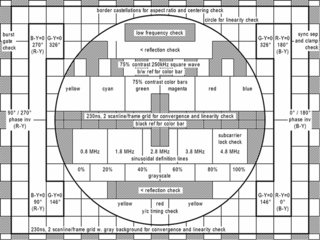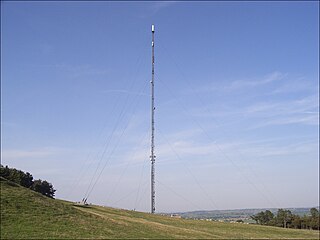Related Research Articles

Very high frequency (VHF) is the ITU designation for the range of radio frequency electromagnetic waves from 30 to 300 megahertz (MHz), with corresponding wavelengths of ten meters to one meter. Frequencies immediately below VHF are denoted high frequency (HF), and the next higher frequencies are known as ultra high frequency (UHF).

Ultra high frequency (UHF) is the ITU designation for radio frequencies in the range between 300 megahertz (MHz) and 3 gigahertz (GHz), also known as the decimetre band as the wavelengths range from one meter to one tenth of a meter. Radio waves with frequencies above the UHF band fall into the super-high frequency (SHF) or microwave frequency range. Lower frequency signals fall into the VHF or lower bands. UHF radio waves propagate mainly by line of sight; they are blocked by hills and large buildings although the transmission through building walls is strong enough for indoor reception. They are used for television broadcasting, cell phones, satellite communication including GPS, personal radio services including Wi-Fi and Bluetooth, walkie-talkies, cordless phones, satellite phones, and numerous other applications.

Terrestrial television is a type of television broadcasting in which the television signal is transmitted by radio waves from the terrestrial (Earth-based) transmitter of a television station to a TV receiver having an antenna. The term terrestrial is more common in Europe and Latin America, while in Canada and the United States it is called broadcast or over-the-air television (OTA). The term "terrestrial" is used to distinguish this type from the newer technologies of satellite television, in which the television signal is transmitted to the receiver from an overhead satellite; cable television, in which the signal is carried to the receiver through a cable; and Internet Protocol television, in which the signal is received over an Internet stream or on a network utilizing the Internet Protocol. Terrestrial television stations broadcast on television channels with frequencies between about 52 and 600 MHz in the VHF and UHF bands. Since radio waves in these bands travel by line of sight, reception is generally limited by the visual horizon to distances of 64–97 kilometres (40–60 mi), although under better conditions and with tropospheric ducting, signals can sometimes be received hundreds of kilometers distant.

Amateur television (ATV) is the transmission of broadcast quality video and audio over the wide range of frequencies of radio waves allocated for radio amateur (Ham) use. ATV is used for non-commercial experimentation, pleasure, and public service events. Ham TV stations were on the air in many cities before commercial television stations came on the air. Various transmission standards are used, these include the broadcast transmission standards of NTSC in North America and Japan, and PAL or SECAM elsewhere, utilizing the full refresh rates of those standards. ATV includes the study of building of such transmitters and receivers, and the study of radio propagation of signals travelling between transmitting and receiving stations.
The L band is the Institute of Electrical and Electronics Engineers (IEEE) designation for the range of frequencies in the radio spectrum from 1 to 2 gigahertz (GHz). This is at the top end of the ultrahigh frequency (UHF) band, at the lower end of the microwave range.
The radio spectrum is the part of the electromagnetic spectrum with frequencies from .03 Hz to 3,000 GHz (3 THz). Electromagnetic waves in this frequency range, called radio waves, are widely used in modern technology, particularly in telecommunication. To prevent interference between different users, the generation and transmission of radio waves is strictly regulated by national laws, coordinated by an international body, the International Telecommunication Union (ITU).
The following tables show the frequencies assigned to broadcast television channels in various regions of the world, along with the ITU letter designator for the system used. The frequencies shown are for the analogue video and audio carriers. The channel itself occupies several megahertz of bandwidth. For example, North American channel 1 occupies the spectrum from 44 to 50 MHz. See Broadcast television systems for a table of signal characteristics, including bandwidth, by ITU letter designator.
In North American broadcast television frequencies, channel 1 was a former broadcast (over-the-air) television channel which was removed from service in 1948.
Digital terrestrial television in the United Kingdom encompasses over 100 television, radio and interactive services broadcast via the United Kingdom's terrestrial television network and receivable with a standard television set. The majority of digital terrestrial television (DTT) services, including the five former analogue channels, are broadcast free-to-air, and a further selection of encrypted pay TV services are also available.

The Moel-y-Parc transmitting station is situated on Moel y Parc, a hill in north-east Wales at the northern end of the Clwydian range, close to the town of Caerwys and several miles (kilometres) north-east of Denbigh. It was built in 1962/1963 by the IBA to bring 405-line VHF ITV television to North Wales and it has been on the air since 1963. Its original height of 229 metres (751 ft) made it the tallest structure in North Wales and it stands on land that is itself about 335 metres (1,099 ft) above sea level. In 1965, VHF television transmissions from the BBC commenced from the site.

The Wenvoe transmitting station, officially known as Arqiva Wenvoe, is the main facility for broadcasting and telecommunications for South Wales and the West of England. It is situated close to the village of Wenvoe in the Vale of Glamorgan, Wales, in the UK.
Channel 37 is an intentionally unused ultra-high frequency (UHF) television broadcasting channel by countries in most of ITU region 2 such as the United States, Canada, Mexico and Brazil. The frequency range allocated to this channel is important for radio astronomy, so all broadcasting is prohibited within a window of frequencies centred typically on 611 MHz. Similar reservations exist in portions of the Eurasian and Asian regions, although the channel numbering varies.
The Oxford transmitting station is a broadcasting and telecommunications facility, situated on land 129.5 metres (425 ft) above Ordnance Datum to the north east of the city of Oxford, in Oxfordshire, England. It has a guyed steel lattice mast which is 154.4 metres (507 ft) in height to the top of the main steel structure. The UHF television antenna, which consist of a vertical array of transmitting panels, is mounted above the steel structure. The total height of the mast to the top of this UHF antenna is 165.7 metres (544 ft). It is owned and operated by Arqiva.
Band III is the name of the range of radio frequencies within the very high frequency (VHF) part of the electromagnetic spectrum from 174 to 240 megahertz (MHz). It is primarily used for radio and television broadcasting. It is also called high-band VHF, in contrast to Bands I and II.
Band I is a range of radio frequencies within the very high frequency (VHF) part of the electromagnetic spectrum. The first time there was defined "for simplicity" in Annex 1 of "Final acts of the European Broadcasting Conference in the VHF and UHF bands - Stockholm, 1961". Band I ranges from 47 to 68 MHz for the European Broadcasting Area, and from 54 to 88 MHz for the Americas and it is primarily used for television broadcasting in compliance with ITU Radio Regulations. With the transition to digital TV, most Band I transmitters have already been switched off.
Television frequency allocation has evolved since the start of television in Australia in 1956, and later in New Zealand in 1960. There was no coordination between the national spectrum management authorities in either country to establish the frequency allocations. The management of the spectrum in both countries is largely the product of their economical and political situation. New Zealand didn't start to develop television service until 1965 due to World War 2 and its economic harm in the country's economy.
Band V is the name of a radio frequency range within the ultra high frequency part of the electromagnetic spectrum. It is not to be confused with the V band in the extremely high frequency part of the spectrum.
CCIR System B was the 625-line analog broadcast television system which at its peak was the system used in most countries. It is being replaced across Western Europe, part of Asia and Africa by digital broadcasting.

UHF television broadcasting is the use of ultra high frequency (UHF) radio for over-the-air transmission of television signals. UHF frequencies are used for both analog and digital television broadcasts. UHF channels are typically given higher channel numbers, like the US arrangement with VHF channels (initially) 1 to 13, and UHF channels (initially) numbered 14 to 83. Compared with an equivalent VHF television transmitter, to cover the same geographic area with a UHF transmitter requires a higher effective radiated power, implying a more powerful transmitter or a more complex antenna. However, the additional channels allow more broadcasters in a given region without causing objectionable mutual interference.
The Pan-American television frequencies are different for terrestrial and cable television systems. Terrestrial television channels are divided into two bands: the VHF band which comprises channels 2 through 13 and occupies frequencies between 54 through 216 MHz, and the UHF band, which comprises channels 14 through 36 and occupies frequencies between 470 and 700 MHz. These bands are different enough in frequency that they often require separate antennas to receive, and separate tuning controls on the television set. The VHF band is further divided into two frequency ranges: VHF low band between 54 and 88 MHz, containing channels 2 through 6, and VHF high band between 174 and 216 MHz, containing channels 7 through 13. The wide spacing between these frequency bands is responsible for the complicated design of rooftop TV antennas. The UHF band has higher noise and greater attenuation, so higher gain antennas are often required for UHF.
References
- 1 2 3 "Frequency characteristics and radio parameters". Swiss Federal Office of Communications. 2009-01-01. Retrieved 2009-05-17.
- 1 2 Tozer, Edwin Paul J. (2004). Broadcast engineer's reference book. Focal Press. p. 166. ISBN 0-240-51908-6 . Retrieved 2009-05-17.
- 1 2 "700 MHz: Spectrum Issues". Ericsson India Ltd. 2009. Retrieved 2009-05-17.
- 1 2 "TECHNICAL ASPECTS IN SPECTRUM ALLOCATION FOR DVB-UMTS CONVERGENCE TERMINALS". DVB-UMTS Group and EICTA. 2003. Archived from the original on June 6, 2007. Retrieved 2009-05-17.
- 1 2 "Television aerials factsheet" (PDF). British Broadcasting Corporation. Archived from the original (PDF) on 2011-11-25. Retrieved 2012-07-07.
- ↑ "UHF channel and frequency guide". Digital Spy Limited. Archived from the original on 18 May 2007. Retrieved 2007-05-17.
- ↑ "Aerial Groups / Widebands". A.T.V. (Aerials and Television). Archived from the original on 23 April 2009. Retrieved 2009-05-17.